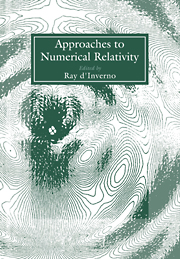Book contents
- Frontmatter
- Contents
- Contributors
- Introduction
- Preface
- PART A THEORETICAL APPROACHES
- PART B PRACTICAL APPROACHES
- Numerical asymptotics
- Instabilities in rapidly rotating polytropes
- Gravitational radiation from coalescing binary neutron stars
- “Critical” behaviour in massless scalar field collapse
- Godunov-type methods applied to general relativistic stellar collapse
- Astrophysical sources of gravitational waves and neutrinos
- Gravitational radiation from 3D gravitational stellar core collapse
- A vacuum fully relativistic 3D numerical code
- Solution of elliptic equations in numerical relativity using multiquadrics
- Self-gravitating thin discs around rotating black holes
- An ADI scheme for a black hole problem
- Time-symmetric ADI and causal reconnection
- The numerical study of topological defects
- Computations of bubble growth during the cosmological quark-hadron transition
- Initial data of axisymmetric gravitational waves with a cosmological constant
- PANEL DISCUSSION
Godunov-type methods applied to general relativistic stellar collapse
Published online by Cambridge University Press: 15 December 2009
- Frontmatter
- Contents
- Contributors
- Introduction
- Preface
- PART A THEORETICAL APPROACHES
- PART B PRACTICAL APPROACHES
- Numerical asymptotics
- Instabilities in rapidly rotating polytropes
- Gravitational radiation from coalescing binary neutron stars
- “Critical” behaviour in massless scalar field collapse
- Godunov-type methods applied to general relativistic stellar collapse
- Astrophysical sources of gravitational waves and neutrinos
- Gravitational radiation from 3D gravitational stellar core collapse
- A vacuum fully relativistic 3D numerical code
- Solution of elliptic equations in numerical relativity using multiquadrics
- Self-gravitating thin discs around rotating black holes
- An ADI scheme for a black hole problem
- Time-symmetric ADI and causal reconnection
- The numerical study of topological defects
- Computations of bubble growth during the cosmological quark-hadron transition
- Initial data of axisymmetric gravitational waves with a cosmological constant
- PANEL DISCUSSION
Summary
Abstract. We have extended some high-resolution shock-capturing methods, designed recently to solve nonlinear hyperbolic systems of conservation laws, to the general-relativistic hydrodynamic system of equations and applied them to the study of the gravitational collapse of spherically symmetric configurations.
INTRODUCTION
Several topics are of current interest among astrophysicists working in the field of stellar collapse: (i) The equation of state for both subnuclear and supranuclear densities. Alongside the theoretical problems concerned here, there is also the technical problem of making both approaches consistent with each other, as well as sufficiently fast to compute in stellar collapse calculations (see Lattimer and Swesty, 1992). (ii) The coupling between neutrinos and matter in connection with the feasibility of the so-called delayed mechanism. (iii) The correct modelling of shocks in order to conserve total energy along the propagation of the shock formed in the collapse after bounce. In the last years, a part of our research has been addressed to this point.
In a previous paper (Martí et al., 1990, in the next MIM90) we have focussed on the shock formation and propagation such as it appears in the standard scenario of the prompt mechanism. In MIM90 we have undertaken Newtonian stellar collapse calculations with two codes: (i) A standard finite-difference scheme which uses an artificial viscosity technique. (ii) A Godunov-type method which uses a linearized Riemann solver. The initial model and the equation of state was kept fixed in order to be able to compare both methods directly.
- Type
- Chapter
- Information
- Approaches to Numerical Relativity , pp. 223 - 229Publisher: Cambridge University PressPrint publication year: 1992
- 5
- Cited by



